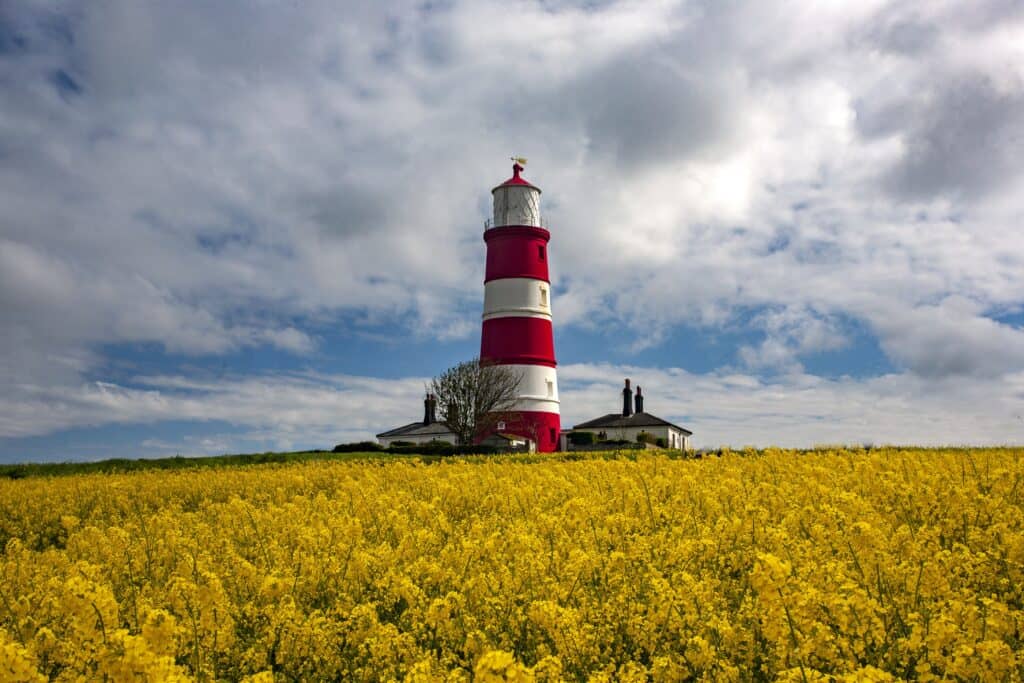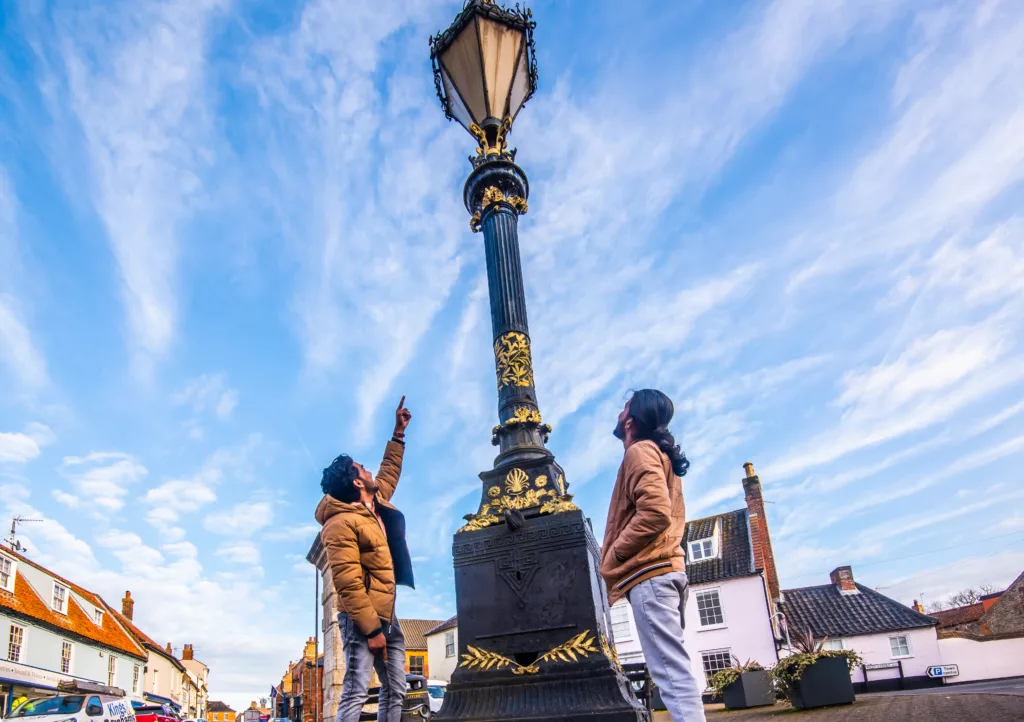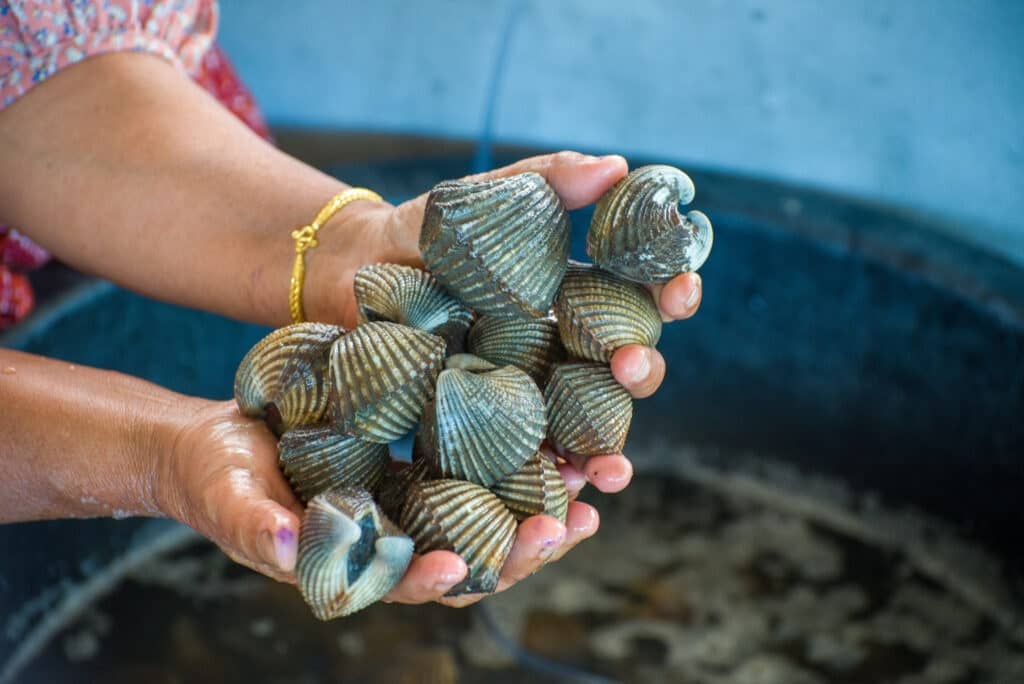
Happisburgh Lighthouse
On the east coast of Norfolk stands an enigmatic lighthouse. Facing the sunrise, it sits proudly on Happisburgh’s soft sandy cliffs where each morning the first rays of light catch the colourful facade, bathing its red and white stripes in the orange glow of a new day. This photogenic landmark was built in the wake of a terrible tragedy. In 1789 a terrible storm blew up. 70 sailing ships were wrecked in the crashing waters and 600 men lost their lives. The subsequent enquiry drew attention to the lack of warning lights between Cromer and Winterton so in 1791 two lighthouses were constructed. The ‘Low Light’ is now demolished but the ‘High Light’ is the distinctive tower that survives today. Once the ‘Low Light’ had gone, during daylight it was necessary to distinguish the Happisburgh lighthouse from the tower at Winterton and so three spectacular broad red bands were painted on the Happisburgh tower, just as you see today.
In 1987 Happisburgh Lighthouse was one of five lighthouses declared redundant with decommissioning scheduled for summer 1988. But local people were not going to allow their beloved lighthouse to be torn down! They mobilised and in 1990 a Private Bill was granted Royal making Happisburgh Britain’s only independently operated working lighthouse. It’s also the oldest working lighthouse in East Anglia, looked after by the Happisburgh Lighthouse Trust. It’s fascinating to look inside so if you can’t make one of the set open days, contact them to arrange a private visit.

Blind Sam and the Pineapple Obelisk
Who, or what, is Blind Sam? And why was getting rid of a pineapple part of the war effort? Head to Holt where even the street furnishings have stories to tell!
The picturesque Georgian market town is brimful of independent shops, delis, restaurants and coffee shops, so you’ll need a good stroll to work up an appetite for more cake! Go for a wander round the pretty streets until you come across Obelisk Plain. Can you find Blind Sam and the Pineapple Obelisk?
The Queen Victoria Jubilee Lantern stood in the Market Place from 1887 to 1921, when it was moved to make way for the war memorial. As well as spouting water from two fountains, it was intended to light the market place at night. But, being powered by the town’s sputtering gas supply, the lamp which sporadically petered out, plunging the street back into darkness. So locals called it Blind Sam.
And what about the fruity tale? Look for an obelisk topped with a pineapple. It was originally one of two gateposts from Melton Constable Park, pineapples being a traditional symbol of welcome. The other was given to the town of Dereham in 1751. Each was used as a milestone, with distances carved in the pillar – which could have been very useful info for an invading army! So at the outbreak of WW2, the Dereham obelisk was (somewhat dramatically) thrown down a well. Holt kept calm and carried on, simply whitewashing the mileage to confound the enemy. Bravo!

The Great Fire of Holt
Pretty little Holt is full of fabulous independent shops, Sunday markets, restaurants and art galleries, magical for Christmas shopping, when the town sparkles with light. But once Holt was lit by a more devastating glow. It was springtime in the reign of Queen Anne. The countryside frothed with white lace flowers named after her and wild garlic scented the woods. The May Day market of 1708 was packed with people from the villages and coast selling fish, meat and eggs. Amid the good humour of a May morning, no-one saw how the fire started.
Flames raced through the market stalls and timber framed houses. Flying sparks caught the church’s thatched roof, setting the building ablaze. In only three terrible hours, the whole medieval town was reduced to smouldering ruins. Yet good can come from the darkest times…
Many homes had been squalid hovels where plague rats bred and poverty festered. Over the next 100 years, thanks to a royal brief, wealthy benefactors and skilled local craftsmen, Holt was rebuilt. Today’s elegant Georgian town rose from ashes, an elegant architectural phoenix. The back lanes and flint stone yards are Victorian, an enchanting labyrinth for imaginative gift hunters. When you stop for lunch, try Byfords on Shirehall Plain, a survivor of the Great Fire. With a 15th century cellar, this cosy warren of flint walls, flagstone floors and wood panels is now a restaurant, coffee shop, deli and delightfully posh B&B, believed to be the oldest house in Holt.

Norfolk Cockler
The Wash is teeming with life. As well as birds and fish, there are crabs, worms, starfish and cockles. Extensive year round work keeps this rich ecosystem protected whilst assuring sustainable development for local livelihoods which depend on the bay, such as the Cocklers.
At low tide Cocklers, who must hold a licence, can be spotted navigating the exposed tidal flats searching for salt-water crustaceans hiding just beneath the mud. Cockles have been harvested here for centuries, most abundant between September and April. Harvesters know the tides well, essential in this treacherous landscape where lack of local knowledge has proved fatal when the sea rushes in.
Watching from the safety of the shoreline you’ll spot solitary figures on their steady methodical journey across the vast expanse of shimmering, rippled mud. A single set of footprints interspersed with mounds of mud marks a Cocklers trail across the Wash lands. The low winter sun highlights each water-sculpted ridge, blurring into blue haze towards the Lincolnshire coast. It’s a truly mesmerising place.
Tucked into the cockle’s crimped, heart-shaped shell is a sweet morsel of delight. Plenty of local seafood restaurants and fishmongers serve this Norfolk delicacy. Boiled or steamed, they’re often cooked with white wine, garlic and cream. Although perhaps their delicate, salty flavour is best celebrated by keeping it simple, served raw and super fresh, with a little vinegar and buttered brown bread. Delicious!
Build your own itinerary
If you fancy creating your own itinerary for a day trip to Norfolk or a longer visit, it couldn’t be simpler. Just go to Search Activities and select from our wide range of free and paid-for experiences, saving any that capture your imagination with the click of a button.
Once you’ve finished, you’ll find all the information stored in My Favourite, where you can drag and drop activities to create your own day-by-day itinerary! You can download this to a calendar and even share it with friends.
